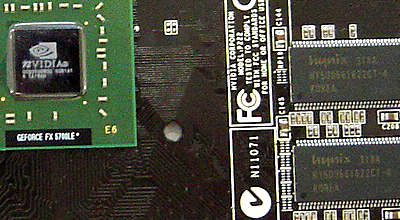 |
||
|
||
| ||
D3D RightMark Beta 4 is released! PowerLeap PL-AXP: an Athlon XP/MP into an older machine Intel and AMD cut processor prices. Enters Athlon XP-M 2600+ Intel CT (Yamhill) = Clackamas Technology. Facts and comments on the threshold of announcement ASUS’s new LGA775 motherboards on Grantsdale/Alderwood, SiS656, PT890/PT892 chipsets NVIDIA GeForce FX5700LE: the first photos and specs Intel Developer Forum Spring 2004: first look D3D RightMark Beta 4 is released! 3D.Rightmark.Org, the independent DirectX 3D Benchmarking Project, released a new version of the D3D RightMark graphics benchmarking suite. The new features of D3D RightMark 1.0.5.0 (Public Beta 4) include:
The source code for version 1.0.5.0 was removed from the main archive and will be available soon separately. And the binaries are available in the official Download section.
PowerLeap PL-AXP: an Athlon XP/MP into an older machine PowerLeap, known as a maker of CPU adapters, introduced its new solution, PL-AXP, an adapter for AMD Athlon/Duron enabling to install the latest AMD Athlon XP/MP processors into older machines.
 Adapter features:
The only thing a user has to do is to choose the right processor for a new system. According to the source, "Only Barton and Thoroughbred-B core-based Athlon XP/MP CPUs are qualified for multiplier unlocking--the PL-AXP does not support unlocking for the Palomino and Thoroughbred-A core-based Athlon CPUs. Locate the label on the Athlon XP/MP CPU and make sure the model number starts with AXDA*******, or the CPU might not be qualified for unlocking. In addition, AMD has officially locked all Athlon CPU internal multipliers produced since Week 34, 2003, and the PL-AXP can´t unlock these CPUs. In order to unlock CPU multipliers with the PL-AXP, you need to use an Athlon CPU that was manufactured before Week 34, 2003 (identified as 0334). The manufacturing date is printed on the Athlon CPU label (please refer to the photo below for location of the manufacturing date)."
 Source: FriendTech
Intel and AMD cut processor prices. Enters Athlon XP-M 2600+ Today we got to know about another price cut for both AMD and Intel processors. Still Intel reduced prices for its three OEM Mobile Celerons only — 2.50GHz, 2.40GHz, and 2.20GHz (in over 1,000-unit quantities):
As for AMD, it cut prices for more products, including Opteron, Athlon MP, Athlon XP, and Athlon XP-M series. The maximum cut of 53% was witnessed in the Opteron camp, while desktop Athlon XP models became just down to 20% cheaper. It´s interesting that this didn´t touch Athlon 64 products, it seems like the company is pleased with the demand for them anyway. Besides, note that AMD price list for the first time features Athlon XP-M 2600+ model for $99. At the same time, the list lost Athlon XP 2100+ and 2000+, Athlon MP 2200+, 2000+, 1800+, and Low Voltage Athlon XP-M 1600+. Prices given as usual, for over 1,000-quantities:
Intel CT (Yamhill) = Clackamas Technology. Facts and comments on the threshold of announcement Without a doubt, one of the key intrigues at IDF Spring 2004 will be the announcement of the new Intel CT technology implying the support of some 64-bit instructions by 32-bit desktop and server similar to AMD Opteron/Athlon 64. Judging by the hype around this theme, our readers are just dying to see something reliable regarding this CT technology. Intel is still keeping the total silence, while various analysts gather drops of leaked information and make assumptions. Materials published on Sunday at CNet and a large publication by Reuters shed some light on some more information about this project. For example, CNet claims that CT stands for Clackamas Technology.
  As there´s no precise information about Clackamas, analysts continue to discuss the possible compatibility of Intel CT and AMD64 and the consequences. In particular, judging by the patent battles between Intel and AMD of 1987-1997, both companies were granted free access to each other´s patented developments and they also signed a cross-licensing agreement. At that AMD agreed not to make obvious clones of Intel´s processors (the result was K6, K6 II, K6III, Athlon, Duron, Athlon 64, and Opteron), and promised to pay Intel royalty for each chip with x86 architecture (plus for such technologies, as SSE/SSE2). Until now such payments were unidirectional only. It´s interesting that if Intel tries to make processors compatible with AMD Opteron/Athlon 64 and operating with 32/64-bit software, it won´t have to pay anything for using AMD developments, according to the court decision of 1995. Moreover, Intel has a right to release an AMD64-compatible instruction set and noone can stop it. So, Intel willing or not willing to accept the AMD64 64-bit instruction set as a base for its 32/64-bit desktop and server chips is totally under control of company´s executives and is not related to any patent problems. Soon we´ll know where Intel turns, as tomorrow IDF Spring 2004 officially starts. We hope we´ll be the first to offer you this critical news.
ASUS’s new LGA775 motherboards on Grantsdale/Alderwood, SiS656, PT890/PT892 chipsets French x86-Secret, referring to a certain presentation, informed on ASUS´s motherboard roadmap that includes solutions on Intel´s Grantsdale (i915) and Alderwood (i925) as well as on SiS´s SiS656 and VIA´s PT890/PT892. As you can see, LGA775 motherboards will have the new model names starting with P5. The next letter seems to mark the chipset family — "G" for i915 (Grantsdale) and "A" for i925 (Alderwood). The next number will stand for the memory type supported — D1" for DDR-I and "D2" for DDR-II.
It´s interesting that Grantsdale-based models include Socket 478 solutions as well. Anyway, the most optimistic availability date is early May 2004. There won´t be as many solutions on chipsets from SiS and VIA, but both Taiwanese manufacturers can be proud for providing the dual-channel support simultaneously with Intel (unlike the previous announcements).
Frankly speaking, I heard about VIA PT892 for the first time. Still judging by P5VD2 features, it´s likely to be a variant of PT890 supporting AGP 8x instead of PCI Express 16x. Source: x86-Secret
NVIDIA GeForce FX5700LE: the first photos and specs The latest WHQL-certified NVIDIA ForceWare 56.55 driver disturbed the Web with the following strings in it: - NVIDIA_NV34DEV_0326.1 = "NVIDIA GeForce FX 5500 - NVIDIA_NV36DEV_0343.1 = "NVIDIA GeForce FX 5700LE - NVIDIA_NV36DEV_0344.1 = "NVIDIA GeForce FX 5700VE Speaking of GeForce FX 5500 specs and features, we will offer you the new material in the nearest future, when we have enough trustworthy information. Pity, but we still have no reliable facts on GeForce FX 5700VE, however, our colleagues from Chinese GZeasy not only provided us with the GeForce FX 5700LE specs, but also shared with us the first photos of a card on this GPU.
   Judging by FC-PGA package of GeForce FX 5700LE GPU, we suppose it will be selected from 0.13µm NV36 scrappage. Similar to the more powerful 5700/5700 Ultra, it features CineFX 2.0 engine, supports IntelliSample, HCT, and UltraShadow, however its clock rate is reduced to 250MHz (vs. 425MHz of a standard GeForce FX 5700). The GeForce FX 5700LE-based card shown on the photo, has 4-layer P222 PCB designed totally different from P191 boards of GeForce FX 5700 and P141 boards of GeForce FX 5600. The card on GeForce FX 5700LE has eight Hynix´s 4ns DDR memory chips, i.e. 128MB of 128-bit memory. Well, such an off-season, when the previous chip is "mastered" (though can´t say GF FX 5700 Ultra is available in volumes now), and the new one exists only in roadmaps, is the best time to release inexpensive GPUs with reduced clock rates. It seems that 5700LE-based solutions operating at 250/400MHz will soon compete with the previous "LE" solutions, GeForce FX 5600XT cards clocked at 235/400MHz. Source: GZeasy
Intel Developer Forum Spring 2004: first look IDF Spring 2004, which opens in San Francisco on February, 17 and lasts till 19, is one of the most anticipated events of the year. IDF will also be held in Tokyo, Taibei, Beijing and Barselona during March-April, 2004. IDF has been setting the trends for the next months for several years now, and this one is not going to be an exception. Our readers will surely be glad to find out that Alexander Vorobiev, representative of iXBT.com, has already arrived in San Francisco and is having a rest after the 20-hour flight and getting ready for the grand opening tomorrow. As there is nothing to report from IDF yet we decided to publish a couple of entertaining photos from Alexander’s trip log. Here’s the great NY smog.
 San Francisco at night. View from the hotel room.
 The same view at morning.
 Some words about key events on this IDF. Tuesday, Feb. 17
Wednesday, Feb. 18:
Thursday, Feb. 19
Of course, the program is not limited by these keynotes. Different issues regarding promising hi-tech technologies, personal computing products, servers, communication equipment and pocket computers will also be covered at this IDF. Another noteworthy event is a two-day conference devoted to solutions. It is to take place on Feb. 17-18 and is aimed at people making decisions in the field of information technologies, developers and those working in the sphere of applications and other software engineering fields. In addition to the solutions conference, another one will be held for OEM builders, hardware producers and new architecture developers. This conference will be devoted to systems. In one word, this IDF is going to be filled with extremely
interesting events and will certainly provide material for some good
news or even sensations. Well, stay tuned and come often to check our
newsline!
Write a comment below. No registration needed!
|
Platform · Video · Multimedia · Mobile · Other || About us & Privacy policy · Twitter · Facebook Copyright © Byrds Research & Publishing, Ltd., 1997–2011. All rights reserved. | ||||||||||||||||||||||||||||||||||||||||||||||||||||||||||||||||||||||||||||||||||||||||||||||||||||||||||||||||||||||||||||||||||||||||||||||||||||||||||||||||||||||||||||||||||||||||||||||||||||||||||||||||||||||||||||||||||||||||||||||||||||||||||||||||||||||